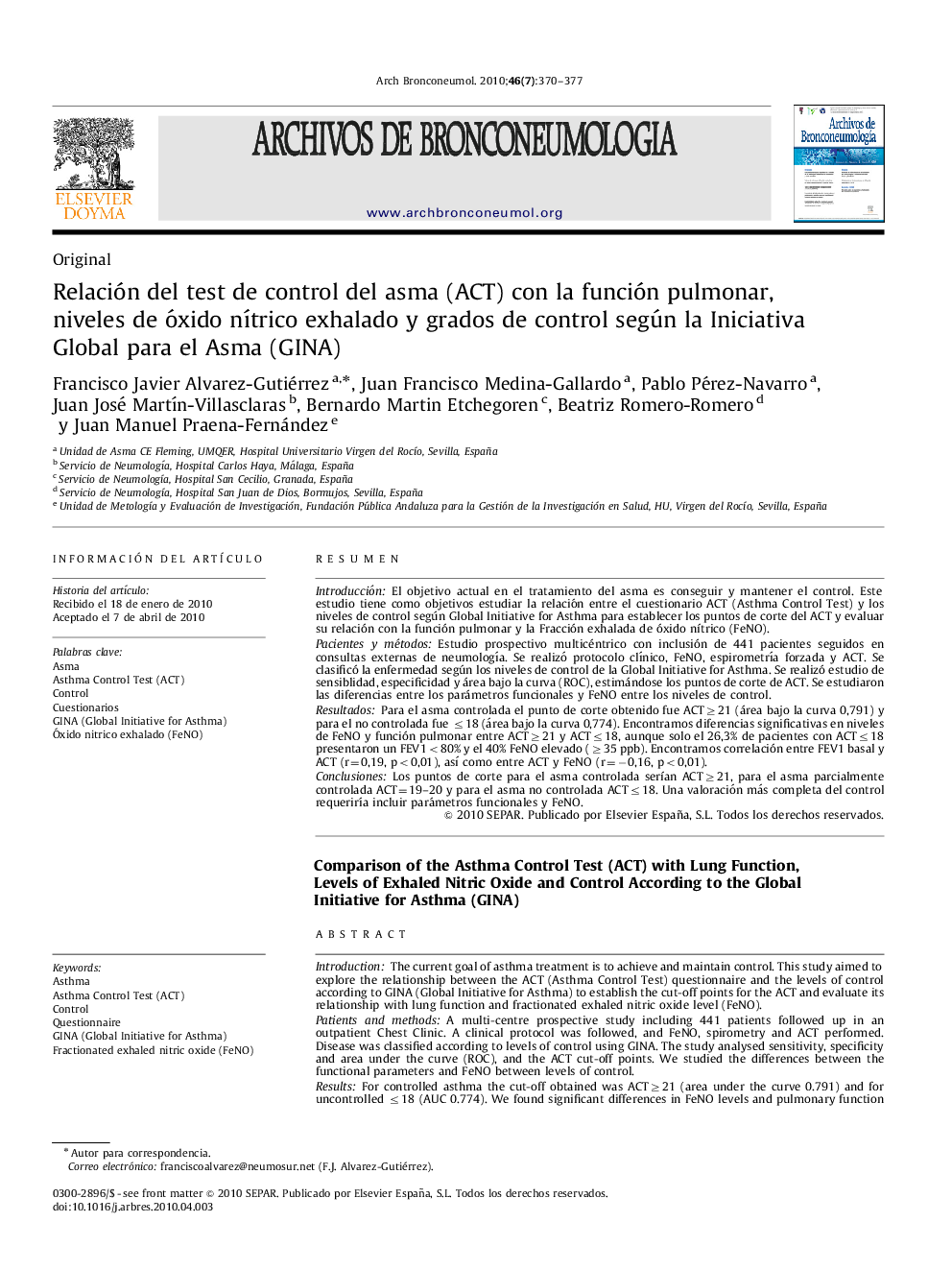| کد مقاله | کد نشریه | سال انتشار | مقاله انگلیسی | نسخه تمام متن |
|---|---|---|---|---|
| 4204010 | 1279559 | 2010 | 8 صفحه PDF | دانلود رایگان |

ResumenIntroducciónEl objetivo actual en el tratamiento del asma es conseguir y mantener el control. Este estudio tiene como objetivos estudiar la relación entre el cuestionario ACT (Asthma Control Test) y los niveles de control según Global Initiative for Asthma para establecer los puntos de corte del ACT y evaluar su relación con la función pulmonar y la Fracción exhalada de óxido nítrico (FeNO).Pacientes y métodosEstudio prospectivo multicéntrico con inclusión de 441 pacientes seguidos en consultas externas de neumología. Se realizó protocolo clínico, FeNO, espirometría forzada y ACT. Se clasificó la enfermedad según los niveles de control de la Global Initiative for Asthma. Se realizó estudio de sensiblidad, especificidad y área bajo la curva (ROC), estimándose los puntos de corte de ACT. Se estudiaron las diferencias entre los parámetros funcionales y FeNO entre los niveles de control.ResultadosPara el asma controlada el punto de corte obtenido fue ACT≥21 (área bajo la curva 0,791) y para el no controlada fue ≤18 (área bajo la curva 0,774). Encontramos diferencias significativas en niveles de FeNO y función pulmonar entre ACT≥21 y ACT≤18, aunque solo el 26,3% de pacientes con ACT≤18 presentaron un FEV1<80% y el 40% FeNO elevado (≥35 ppb). Encontramos correlación entre FEV1 basal y ACT (r=0,19, p<0,01), así como entre ACT y FeNO (r=−0,16, p<0,01).ConclusionesLos puntos de corte para el asma controlada serían ACT≥21, para el asma parcialmente controlada ACT=19–20 y para el asma no controlada ACT≤18. Una valoración más completa del control requeriría incluir parámetros funcionales y FeNO.
IntroductionThe current goal of asthma treatment is to achieve and maintain control. This study aimed to explore the relationship between the ACT (Asthma Control Test) questionnaire and the levels of control according to GINA (Global Initiative for Asthma) to establish the cut-off points for the ACT and evaluate its relationship with lung function and fractionated exhaled nitric oxide level (FeNO).Patients and methodsA multi-centre prospective study including 441 patients followed up in an outpatient Chest Clinic. A clinical protocol was followed, and FeNO, spirometry and ACT performed. Disease was classified according to levels of control using GINA. The study analysed sensitivity, specificity and area under the curve (ROC), and the ACT cut-off points. We studied the differences between the functional parameters and FeNO between levels of control.ResultsFor controlled asthma the cut-off obtained was ACT≥21 (area under the curve 0.791) and for uncontrolled ≤18 (AUC 0.774). We found significant differences in FeNO levels and pulmonary function among ACT≥21 and ACT≤18, although only 26.3% of patients with ACT≤18 had a FEV1 <80% and 40% higher FeNO (≥35 ppb). We found a correlation between baseline FEV1 and ACT (r=0.19, P<0.01) and between ACT and FeNO (r=−0.16, P<0.01).ConclusionsThe cut-off points would be, for controlled asthma ACT≥21, partly controlled asthma ACT=19–20 and uncontrolled asthma ACT≤18. A more complete assessment would require including monitoring operating parameters and FeNO.
Journal: Archivos de Bronconeumología - Volume 46, Issue 7, July 2010, Pages 370–377